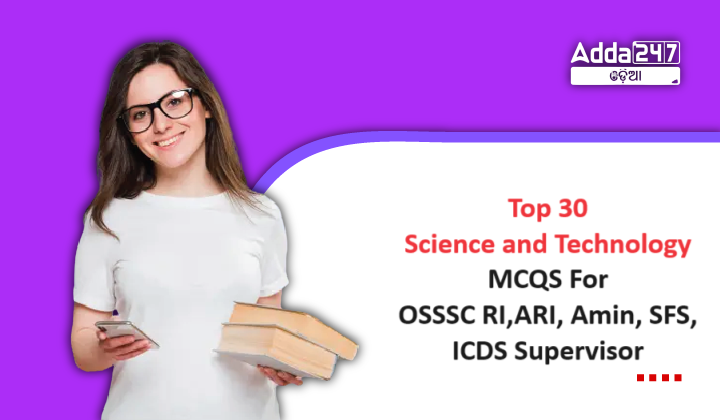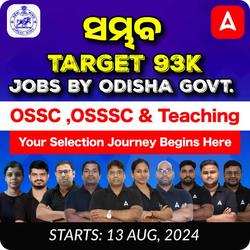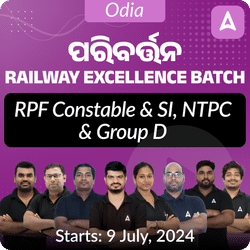Preparing for exams like OSSSC RI, ARI, Amin, SFS, ICDS Supervisor necessitates a thorough understanding of science and technology concepts. To aid in your preparation, here’s a selection of the top 30 multiple-choice questions (MCQs) covering various aspects of science and technology. These questions delve into topics ranging from basic scientific principles to cutting-edge technological advancements. By engaging with these MCQs, candidates can enhance their grasp of crucial scientific concepts and stay abreast of the latest developments in technology. Whether it’s understanding the fundamentals of physics, biology, chemistry, or exploring the latest innovations in the field of technology, these MCQs serve as valuable tools to assess and augment one’s knowledge base.
Top 30 Science and Technology MCQS For OSSSC RI,ARI, Amin, SFS, ICDS Supervisor
- What was the primary objective of the Chang’e-6 mission?
(a) To explore the moon’s surface for potential human colonization.
(b) To perform the first human sampling and return mission from the far side of the moon.
(c) To establish a lunar base for long-term research.
(d) To test new spacecraft technologies for future missions.
Answer: (b) To perform the first human sampling and return mission from the far side of the moon. - Where did the Chang’e-6 spacecraft land on the moon?
(a) The moon’s equator
(b) The near side of the moon
(c) The South Pole-Aitken Basin on the far side of the moon
(d) The Sea of Tranquility
Answer: (c) The South Pole-Aitken Basin on the far side of the moon - Which mission marked China’s first successful landing on the far side of the moon?
(a) Chang’e-5
(b) Chang’e-6
(c) Chang’e-3
(d) Chang’e-4
Answer: (d) Chang’e-4 - What new scientific analysis has pushed back the origin of the Tamil-Brahmi script?
(a) Carbon Dating
(b) Accelerator Mass Spectrometry (AMS) dating
(c) Thermoluminescence Dating
(d) Uranium-Series Dating
Answer: (b) Accelerator Mass Spectrometry (AMS) dating - According to recent findings, what is the revised origin date of the Tamil-Brahmi script?
(a) 5th Century BCE
(b) 6th Century BCE
(c) 7th Century BCE
(d) 8th Century BCE
Answer: (c) 7th Century BCE - Which location provides the earliest date for the Tamil-Brahmi script according to the new findings?
(a) Madurai
(b) Chennai
(c) Sivagalai in Thoothukudi district
(d) Coimbatore
Answer: (c) Sivagalai in Thoothukudi district - What does the new date for the Tamil-Brahmi script challenge?
(a) The introduction of Brahmi scripts during the Gupta period
(b) The belief that Brahmi scripts were introduced during Asokan times
(c) The timeline of the Sangam era
(d) The origin of the Sanskrit language
Answer: (b) The belief that Brahmi scripts were introduced during Asokan times - What kind of evidence was found that shows the penetration and level of literacy during Early Historic times in Tamil Nadu?
(a) Ancient coins
(b) Inscribed potsherds
(c) Stone inscriptions
(d) Ancient manuscripts
Answer: (b) Inscribed potsherds - How does the revised date of the Tamil-Brahmi script impact India’s historical timeline?
(a) It shortens the timeline of the Sangam era by three hundred years
(b) It pushes back the Sangam era by three hundred years
(c) It confirms the previously accepted dates for the Sangam era
(d) It has no impact on the historical timeline
Answer: (b) It pushes back the Sangam era by three hundred years - What recent findings have contributed to the momentum for rewriting India’s history from Tamil Nadu?
(a) Findings from ancient texts discovered in 2019
(b) Archaeological discoveries from 2021
(c) Scientific analyses from 2019 and 2021
(d) Reports on ancient trade routes from 2022
Answer: (c) Scientific analyses from 2019 and 2021 - What was the recent concern raised by the opposition regarding postal ballots?
(a) Delay in postal ballot delivery
(b) Prioritization of postal ballot counting before EVM counting
(c) Increase in postal ballot fraud
(d) Decrease in postal ballot availability
Answer: (b) Prioritization of postal ballot counting before EVM counting - Who is eligible to vote via postal ballot?
(a) Only senior citizens
(b) Only government employees
(c) Service voters and essential service workers
(d) Only absentee voters
Answer: (c) Service voters and essential service workers - Which of the following is NOT a category of eligible postal ballot voters?
(a) Senior citizens aged 80 and above
(b) Electors on election duty
(c) Students studying abroad
(d) Persons with Disabilities (PwDs)
Answer: (c) Students studying abroad - What are Virus-like Particles (VLPs)?
(a) Infectious viruses used for vaccine development
(b) Non-infectious molecules that resemble viruses
(c) Synthetic viruses created for research purposes
(d) Particles that cause viral infections
Answer: (b) Non-infectious molecules that resemble viruses - What significant advancement did scientists at the Institute of Advanced Virology achieve?
(a) Discovery of a new virus
(b) Development of infectious virus particles
(c) Creation of non-infectious Nipah virus-like particles (VLPs)
(d) Invention of a new antiviral drug
Answer: (c) Creation of non-infectious Nipah virus-like particles (VLPs) - Which of the following diseases is NOT mentioned as being targeted by VLPs-based vaccines?
(a) HPV
(b) Hepatitis B
(c) Malaria
(d) Tuberculosis
Answer: (d) Tuberculosis - In the context of VLPs, what is the primary purpose of mimicking real viral molecules?
(a) To cause disease symptoms for research
(b) To enhance the virulence of the virus
(c) To trigger an immune response without causing disease
(d) To produce actual viruses for laboratory testing
Answer: (c) To trigger an immune response without causing disease - Which of the following groups is eligible for postal voting due to preventive detention?
(a) Railway workers
(b) Government officials
(c) Individuals under preventive detention orders
(d) Media personnel
Answer: (c) Individuals under preventive detention orders - For which assembly elections was postal voting available for Persons with Disabilities (PwDs)?
(a) 2015 Delhi Assembly elections
(b) 2020 Delhi Assembly elections
(c) 2019 Lok Sabha elections
(d) 2021 West Bengal Assembly elections
Answer: (b) 2020 Delhi Assembly elections - How do VLPs contribute to immunity against real viruses?
(a) By causing mild infections that build immunity
(b) By directly treating viral infections
(c) By mimicking viral structures to stimulate an immune response
(d) By blocking viral entry into cells
Answer: (c) By mimicking viral structures to stimulate an immune response - What was the percentage increase in Nitrous Oxide (N2O) emissions between 1980 and 2020?
(a) 20%
(b) 30%
(c) 40%
(d) 50%
Answer: (c) 40% - Which country is the largest emitter of Nitrous Oxide (N2O)?
(a) India
(b) The US
(c) Brazil
(d) China
Answer: (d) China - What proportion of Nitrous Oxide emissions in the past decade was attributed to agriculture according to the Global Carbon Project?
(a) 50%
(b) 60%
(c) 74%
(d) 80%
Answer: (c) 74% - Which of the following is NOT a primary source of Nitrous Oxide emissions?
(a) Nitrogen fertilizers
(b) Animal manure
(c) Industrial processes
(d) Fossil fuel combustion
Answer: (d) Fossil fuel combustion - N2O is how many times more potent than CO2 over 100 years?
(a) 100 times
(b) 150 times
(c) 200 times
(d) 273 times
Answer: (d) 273 times - To keep global temperature rise below 2 degrees Celsius, by what percentage must N2O emissions from human activities decrease by 2050 from 2019 levels?
(a) 10%
(b) 15%
(c) 20%
(d) 25%
Answer: (c) 20% - Which project has recently concluded its first phase and organized an event named “Phenome India Unboxing 1.0”?
(a) Phenome India
(b) India Health Initiative
(c) CSIR Cardio-Metabolic Study
(d) India Wellness Project
Answer: (a) Phenome India - The Phenome India-CSIR Health Cohort Knowledgebase (PI-CheCK) aims to develop risk prediction models specifically for which group?
(a) Western populations
(b) Indian population
(c) Global population
(d) Asian populations
Answer: (b) Indian population - Which of the following diseases is NOT a focus of the Phenome India project?
(a) Diabetes
(b) Liver diseases
(c) Cardiac diseases
(d) Cancer
Answer: (d) Cancer - The Phenome India project promotes which model of healthcare?
(a) Reactive Medicine
(b) Preventive Healthcare
(c) Precision Medicine
(d) Standardized Medicine
Answer: (c) Precision Medicine










